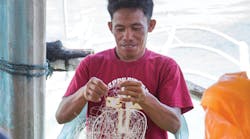If you walk on a carpet from Interface's new Net Effect line, you'll likely admire the ocean-inspired blue, green, gray, and sand patterns. But what you may fail to appreciate is that some of the nylon fiber in the carpet had its supply chain origin in the fishing nets used by Philippine fishermen.
In 2011, Interface, the Atlanta-based manufacturer of carpet tiles with $1 billion in annual sales, found out that its yarn supplier Aquafil had launched a 100% recycled nylon yarn and that some of the material came from fishing nets. Interface is committed to reducing its use of virgin raw materials and eliminating its impact on the environment by 2020. While nets may seem an unlikely supply source, consider that the U.N. Food and Agriculture Organization estimates that 640,000 tons of fishing gear is discarded annually, creating a serious hazard for marine life.
See Also: Global Manufacturing Economy Trends & Analysis
Miriam Turner, Interface's vice president of co-innovation, put together a team of experts to study how the firm could integrate the nets into its supply chain. She said she saw a chance to "reimagine" the supply chain, attacking a pollution problem while benefitting "some of the poorest people in the world."
They focused on setting up a test case in the Philippines, working closely with Dr. Nick Hill of the Zoological Society of London. Interface and its NGO partners arranged to gather nylon fishing nets from villagers on 26 islands. These islands are in the Danajon Bank double barrier reef, an endangered ecological treasure thought to be the origin of many marine species. Discarded fishing nets are just one of many threats to the reef.
In these islands, there was no solid waste system to dispose of the nets. But in Interface's Net-Works program, villagers take the nets to a central spot and exchange them for cash from the chairman of the community bank. From the villages, the nets are taken to a collection point, baled and sent to the port of Cebu, where the nets are put on a freighter to Italy. From there, they are trucked to Aquafil's facility in Ljubljana, Slovenia.
Aquafil takes the nets, along with manufacturers' nylon fluff and other waste materials, and uses its Econyl regeneration system to produce nylon 6 polymer. Aquafil says its process saves on fossil fuels compared to producing virgin material and allows waste polymers to be used an infinite number of times. Today, the company obtains about 70% of the material for the process from industrial waste and 30% from end-of-life products, but hopes to increase the latter to 50% of the total.
The nets contribute to the recycled content in the Net Effect carpet tiles, which contain 81% total recycled content and 100% recycled nylon face fiber. The Net-Works recycling program is in its early stages, cautions Turner. At press time, some 10,000 kilograms of nets had been collected and 1.6 tons had been shipped to Aquafil. But Turner told IndustryWeek that each village is likely to be able to gather 200 kilograms of nets per month. Interface plans to expand the program gradually in the Philippines and also hopes to launch similar efforts in Indonesia and Cameroon.
Turner said the origins of the carpet fiber had been a source of inspiration to product designers, architects and other specifiers, not just in terms of the aesthetics of the product but also in considering how changes in the supply chain can benefit the environment and lead to a more sustainable future.
| How do fishing nets end up in Interface's carpet? See the supply chain slideshow at iw.com/net-works. |
At present, 49% of Interface's total raw materials are recycled or bio-based. Turner stresses that the Net-Works project is "not a charitable or philanthropic endeavor." Instead, she said, it is about how the company can set up a program that brings poor people into the value chain in a sustainable way. "We have introduced these villages to Aquafil as new suppliers," she said.



